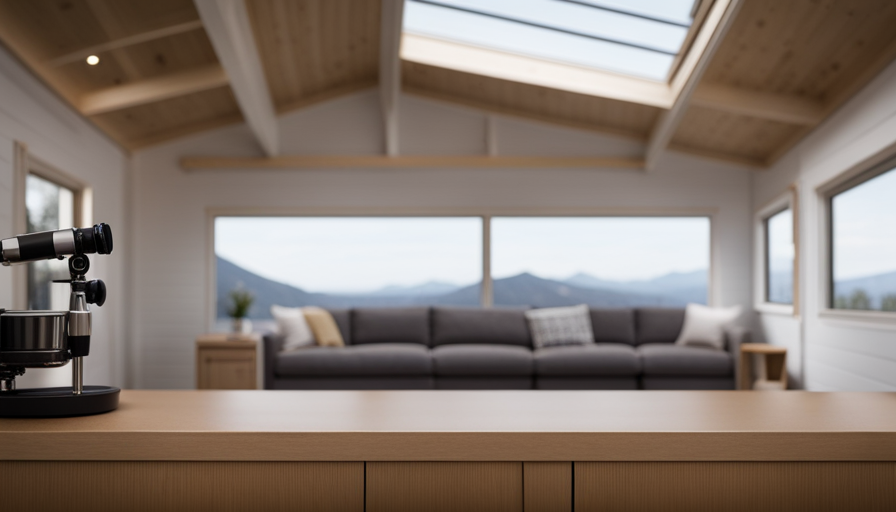One popular saying claims that “good things come in small packages.” This sentiment perfectly captures the essence of tiny homes. These small dwellings have gained popularity for offering a minimalist and environmentally friendly lifestyle for those looking to downsize and simplify. A common question for those considering tiny house living is, “what is the ceiling height?”
Ceiling heights in tiny houses can vary greatly depending on a variety of factors. From the overall design and layout of the house to the materials used and the preferences of the homeowner, there are several considerations to take into account.
In this article, we will explore the concept of tiny houses, delve into the factors that affect ceiling heights, discuss the pros and cons of low ceilings, and provide creative solutions for maximizing vertical space.
So if you’re curious about the heights of ceilings in tiny houses and want to make the most of your limited vertical space, keep reading.
Key Takeaways
- Ceiling heights in tiny houses can vary depending on design, materials, and homeowner preferences.
- Factors such as overall size, space efficiency, mobility considerations, and impact on comfort affect the choice of ceiling heights.
- The average ceiling heights in tiny houses range from 6 to 8 feet.
- Low ceilings in tiny houses create a cozy atmosphere but may also feel claustrophobic.
Understanding the Concept of Tiny Houses
You might be wondering how high the ceilings are in a tiny house and how this concept contributes to the overall design and functionality. Well, let me enlighten you on the factors impacting the cost and design considerations when it comes to ceiling heights in these small living spaces.
One of the primary factors affecting the cost of a tiny house is its size. Since tiny houses have limited square footage, taller ceilings can make the space feel more open and spacious. However, taller ceilings require more materials, which can increase the overall cost of construction.
Design considerations also play a significant role in determining the height of the ceilings. For instance, if you plan to incorporate lofts or mezzanine levels into your tiny house, you may need higher ceilings to accommodate comfortable headroom. Additionally, if you’re considering installing ceiling fans or pendant lights, you’ll need sufficient height to ensure they don’t feel cramped or obstructive.
Considering these factors, it’s essential to strike a balance between cost and design when determining the height of the ceilings in a tiny house. By understanding the impact of ceiling heights on both functionality and aesthetics, you can create a harmonious and efficient living space.
Now, let’s explore the various factors that affect ceiling heights in tiny houses.
Factors Affecting Ceiling Heights in Tiny Houses
One factor that influences the vertical dimensions within compact dwellings is the overall size of the living space. In tiny houses, where space is limited, every inch counts. The height of the ceiling can greatly impact the overall design and functionality of the living area.
Here are three factors that affect the design of ceiling heights in tiny houses:
-
Space efficiency: With limited square footage, designers strive to maximize every inch of available space. Lower ceilings can create a cozy and intimate atmosphere while still allowing for practical use of the vertical space.
-
Mobility considerations: Many tiny houses are built on wheels, allowing for mobility and flexibility. However, taller ceilings can make transportation more challenging, as they increase the overall height and may limit the places where the tiny house can be moved.
-
Impact on comfort: Ceiling height can greatly impact the comfort and livability of a tiny house. Higher ceilings can create a more open and airy feel, while lower ceilings may make the space feel cramped and claustrophobic.
Considering these factors, it’s important for designers to carefully balance the impact of ceiling height on both the functionality and comfort of the tiny house.
In the next section, we’ll explore the average ceiling heights in tiny houses to provide a better understanding of the vertical dimensions within these compact dwellings.
Average Ceiling Heights in Tiny Houses
Maximizing vertical space is crucial in compact dwellings, and the average height of the ceiling in tiny houses plays a significant role in achieving this goal. When it comes to tiny houses, every inch matters, and the ceiling height is no exception.
On average, the ceiling height in tiny houses ranges from 6 to 8 feet. However, it’s important to note that this can vary depending on the design considerations of each individual tiny house. Design considerations such as the overall height of the tiny house, the type of foundation, and the desired aesthetic all play a role in determining the average ceiling height.
For example, if the tiny house is built on wheels, there may be restrictions on the maximum height due to transportation regulations. Additionally, some tiny house owners may opt for lower ceilings to create a cozy and intimate atmosphere, while others may prefer higher ceilings to make the space feel more open and spacious.
Transitioning into the next section about the pros and cons of low ceilings in tiny houses, it’s important to consider the impact of ceiling height on the overall functionality and comfort of the space. While lower ceilings can make heating and cooling more efficient, they may also create a sense of claustrophobia for some individuals.
Pros and Cons of Low Ceilings in Tiny Houses
Opting for low ceilings in your compact dwelling can create a cozy and intimate atmosphere, but it may also lead to a sense of claustrophobia. There are both advantages and disadvantages to having low ceilings in a tiny house.
Advantages:
- Energy Efficiency: With lower ceilings, it becomes easier to maintain a comfortable temperature inside the tiny house. The reduced volume of air to heat or cool helps in energy conservation.
- Design Flexibility: Low ceilings allow for more creativity when it comes to designing the interior space. You can install built-in storage units, loft spaces, or even hanging shelves, making the most of every inch in your tiny home.
- Cozy Ambiance: The lower ceiling height creates a sense of coziness and intimacy, making the space feel warm and inviting.
Disadvantages:
- Limited Vertical Space: Low ceilings can restrict your ability to move freely and may make the space feel cramped, especially for taller individuals.
- Storage Challenges: If you have a lot of belongings, low ceilings can limit your storage options. It may be challenging to fit larger items or tall furniture.
- Lack of Airiness: Low ceilings can make the space feel closed off and lacking in natural light, potentially leading to a feeling of confinement.
In the subsequent section, we will explore creative solutions for maximizing vertical space in tiny houses, providing practical ideas to overcome the limitations of low ceilings.
Creative Solutions for Maximizing Vertical Space
When it comes to maximizing vertical space in tiny houses, there are several creative solutions that can be implemented.
One of the most popular options is to incorporate lofted sleeping areas, which not only save space but also add a cozy and unique element to the design.
Additionally, multifunctional furniture pieces, such as sofa beds or coffee tables with hidden storage, can serve multiple purposes and help optimize the available space.
Lastly, clever storage solutions, like built-in shelves and wall-mounted organizers, can make use of every nook and cranny, ensuring that everything has its place in a tiny home.
Lofted Sleeping Areas
Lofted sleeping areas in tiny houses have surprisingly high ceilings! When it comes to maximizing space in a tiny house, lofted sleeping areas are a popular choice. They allow for a separate sleeping area without taking up valuable floor space.
The high ceilings in these areas provide a sense of openness and comfort, making them perfect for a peaceful night’s sleep.
However, if lofted sleeping areas are not your preference, there are alternatives available. For instance, you can consider using multifunctional furniture that serves a dual purpose, such as a sofa that transforms into a bed or a dining table that can be folded away when not in use.
These alternatives offer flexibility and help to make the most of limited space in a tiny house.
Multifunctional Furniture
If you’re looking to maximize space and add versatility to your living area, multifunctional furniture is the ticket to transforming your tiny house into a dynamic and efficient living space. Space-saving designs are essential in tiny houses, and multifunctional furniture offers innovative solutions.
From sofas that can be converted into beds to coffee tables with hidden storage compartments, these pieces allow you to make the most of every square inch. Transforming furniture not only saves space but also adds functionality to your tiny house.
Whether you need a desk that transforms into a dining table or a bookshelf that doubles as a ladder to access the lofted sleeping area, multifunctional furniture is designed to adapt to your changing needs. With clever storage solutions, you can keep your tiny house organized and clutter-free, making it feel more spacious and inviting.
Clever Storage Solutions
Take advantage of clever storage solutions to optimize every inch of your living space and keep your belongings organized and easily accessible. Here are four hidden storage options and space-saving furniture ideas that can help you make the most of your tiny house:
-
Built-in wall cabinets: Utilize the vertical space by installing custom-built cabinets that blend seamlessly into the walls. These cabinets can store a variety of items, from books and electronics to kitchenware and clothing.
-
Underneath staircase storage: Transform the space underneath your staircase into a practical storage area. Install drawers or shelves to keep items like shoes, bags, and seasonal clothing neatly tucked away.
-
Foldable furniture: Invest in multi-purpose furniture pieces that can be folded and stored when not in use. This includes foldable tables, chairs, and beds, which allow you to maximize the space in your tiny house.
-
Hanging storage solutions: Make use of the vertical space by installing hooks, racks, and shelves on the walls. These can be used to hang and store items such as pots and pans, utensils, and even bicycles.
By incorporating these hidden storage options and space-saving furniture ideas, you can create a more organized and efficient living space in your tiny house. Now let’s explore the personalization and customization options available to make your tiny house truly unique.
Personalization and Customization Options
One of the best things about tiny houses is the endless possibilities for personalization and customization, allowing you to truly make it your own.
Despite their limited space, tiny houses offer ample opportunities to add personalized decor and incorporate various customization options. From choosing the color palette to selecting furniture that suits your style, every aspect can be tailored to reflect your personality and preferences.
When it comes to personalized decor, you can get creative with wall art, photographs, and other decorative items that hold sentimental value. Customization options are also abundant, with the ability to choose from a range of materials for flooring, countertops, and cabinets. You can opt for eco-friendly options like bamboo or reclaimed wood to align with your sustainability goals.
Moreover, personalization and customization extend beyond aesthetics. You can modify the layout and functionality of your tiny house to suit your needs. From redesigning the kitchen layout to creating multifunctional furniture pieces, the possibilities are endless. Additionally, incorporating hidden storage solutions and built-in shelving can maximize the use of space while maintaining a personalized touch.
With the freedom to personalize and customize your tiny house, you can create a space that truly reflects your style and meets your needs.
Now, let’s explore some tips for making the most of limited vertical space.
Tips for Making the Most of Limited Vertical Space
Imagine walking into a cozy sanctuary where the walls seem to stretch endlessly upwards, beckoning you to take advantage of the vertical space and create a truly unique and functional living area. In a tiny house, maximizing vertical space is essential to make the most of the limited square footage. By employing some clever strategies, you can create a spacious and organized environment.
One key aspect of making the most of vertical space is maximizing storage capacity. In a tiny house, storage is crucial, and utilizing the vertical space can greatly increase your options. Consider incorporating built-in shelves and cabinets that extend all the way up to the ceiling. This not only provides ample storage for your belongings but also draws the eye upward, creating the illusion of higher ceilings.
To further optimize vertical space, you can use multi-functional furniture. Look for pieces that serve multiple purposes, such as a bed with built-in storage drawers or a dining table that can be folded up against the wall when not in use. Additionally, consider utilizing vertical wall space for hanging storage solutions like hooks, racks, and pocket organizers.
By thoughtfully arranging your furniture and belongings and using creative storage solutions, you can make the most of the vertical space in your tiny house. These strategies will help create a sense of openness and organization, even in a small area. As you strive to maximize vertical space, it’s important to overcome challenges with low ceilings, which we will explore in the next section.
Overcoming Challenges with Low Ceilings
To fully optimize your vertical space, you must tackle the unique obstacles presented by limited overhead room. Here are four tips to help you overcome challenges with low ceilings and make the most of your tiny house:
-
Utilize vertical storage: With limited floor space, it’s essential to look up for storage solutions. Install shelves, hooks, and hanging organizers on walls to keep things off the ground and make the most of your vertical space.
-
Choose low-profile furniture: Opt for furniture pieces that are lower in height, such as low platform beds or shorter bookcases. This will create a sense of openness and prevent the space from feeling cramped.
-
Maximize natural light: One way to make low ceilings feel less restrictive is by maximizing natural light. Use light-colored curtains or blinds that allow sunlight to filter through. Additionally, strategically placing mirrors can help reflect light and make the space appear larger.
-
Incorporate skylights: Installing skylights can be a game-changer in a tiny house with low ceilings. Not only do they bring in more natural light, but they also create a sense of openness and provide a view of the sky above.
By implementing these tips, you can overcome the challenges of low ceilings and create a functional and inviting space in your tiny house.
Now, let’s explore some real-life examples and inspirations to further inspire your design choices.
Real-life Examples and Inspirations
Get ready to be inspired by some real-life examples and ideas that will help you transform your compact living space into a cozy oasis with plenty of vertical storage and natural light.
When it comes to tiny houses, maximizing vertical space is essential. One clever solution is to install floor-to-ceiling shelving units that double as storage and display areas. These units not only provide ample storage for your belongings but also draw the eye upward, creating the illusion of higher ceilings.
Another idea is to incorporate loft spaces into your tiny house design. Lofts can serve as sleeping quarters, freeing up valuable floor space for other activities. They also add visual interest and make your tiny house feel more spacious.
Skylights are another fantastic option for bringing in natural light and making your ceilings feel higher. They not only brighten up the space but also create a sense of openness and airiness. By strategically placing skylights throughout your tiny house, you can create a connection with the outdoors and make your ceilings appear higher than they actually are.
These real-life examples and vertical space solutions will help you make the most of your tiny house, creating a comfortable and visually appealing living space.
With these ideas in mind, let’s move on to some final thoughts and considerations for your tiny house journey.
Final Thoughts and Considerations
When it comes to creating a cozy oasis in a compact living space, it’s important to consider some final thoughts and considerations for your tiny house journey.
Did you know that incorporating natural light through skylights can increase the perceived size of your living space by up to 30%? Maximizing natural light in your tiny house is essential to make it feel more open and spacious. Installing skylights or large windows can flood your space with sunlight, creating a bright and airy atmosphere.
In addition to natural light, incorporating greenery can also enhance the overall ambiance of your tiny house. Plants not only add a touch of nature and beauty to your living space but also improve air quality. They can help filter out toxins and release oxygen, creating a healthier and more vibrant environment. Vertical gardens or hanging planters are great options for tiny homes with limited floor space. You can also use window sills or wall-mounted shelves to display your favorite plants.
When designing your tiny house, think about the placement of windows and the types of plants that thrive in different lighting conditions. Consider using natural materials for window frames and furniture to create a seamless connection with the outdoors.
By maximizing natural light and incorporating greenery, you can transform your tiny house into a tranquil and inviting sanctuary.
Frequently Asked Questions
Can I install a loft or mezzanine in a tiny house with low ceilings?
Yes, you can install a loft or mezzanine in a tiny house with low ceilings. By utilizing clever design techniques and maximizing vertical space, you can create a functional and comfortable sleeping or storage area. Consider using a low-profile loft design that allows for ample headroom below, or a mezzanine that can be accessed via a ladder or staircase. These options will help you optimize the limited space in your tiny house while still maintaining a cozy atmosphere.
Are there any building codes or regulations regarding ceiling heights in tiny houses?
Building code requirements for minimum ceiling height vary depending on the jurisdiction and type of structure. However, in general, most building codes mandate a minimum ceiling height of 7 feet for habitable spaces. This ensures adequate headroom and promotes a safe living environment.
It’s important to consult local building codes and regulations to determine the specific requirements for your tiny house. Compliance with these standards ensures your tiny house meets the necessary safety and livability standards.
How can I create the illusion of higher ceilings in a tiny house?
To create the illusion of higher ceilings in a tiny house and maximize vertical space, there are a few strategies to consider. Firstly, using light colors on the walls and ceilings can help make the space feel more open and airy.
Secondly, installing floor-to-ceiling curtains or vertical stripes can draw the eye upwards, creating the perception of taller ceilings.
Lastly, incorporating tall furniture and shelving units can give the impression of higher ceilings by emphasizing verticality in the space.
What are some alternative options for tiny house layouts with low ceilings?
When it comes to tiny house layouts with low ceilings, there are a few alternative options that can help create a sense of space. One option is to incorporate space-saving furniture, such as foldable tables and built-in storage units. This allows for a more efficient use of the limited space available.
Additionally, maximizing natural light can help create an illusion of higher ceilings. This can be achieved by using large windows, skylights, and light-colored walls to reflect light and make the space feel more open and airy.
Are there any safety concerns or drawbacks to having low ceilings in a tiny house?
Safety concerns and drawbacks can arise when opting for low ceilings in a tiny house. Limited headroom can lead to a higher risk of accidentally bumping into the ceiling or fixtures, potentially causing injuries.
Additionally, low ceilings can make the space feel cramped and claustrophobic, affecting the overall comfort and livability of the tiny house.
It’s important to carefully consider these factors when designing a tiny house to ensure a safe and enjoyable living environment.
Conclusion
After delving into the world of tiny houses and exploring the factors that affect ceiling heights, it’s clear that these compact dwellings offer unique challenges and opportunities. From low ceilings to creative solutions for maximizing vertical space, tiny house living requires a thoughtful approach.
By thinking outside the box and embracing the beauty of limited vertical space, homeowners can create stunning and functional living environments. So, as you embark on your tiny house journey, remember that even with low ceilings, the sky’s the limit when it comes to imagination and ingenuity.
Hi, I’m Emma. I’m the Editor in Chief of Tiny House 43, a blog all about tiny houses. While tree houses are often associated with childhood, they can be the perfect adult retreat. They offer a cozy space to relax and unwind, surrounded by nature. And since they’re typically built on stilts or raised platforms, they offer stunning views that traditional homes simply can’t match. If you’re looking for a unique and romantic getaway, a tree house tiny house might just be the perfect option.










